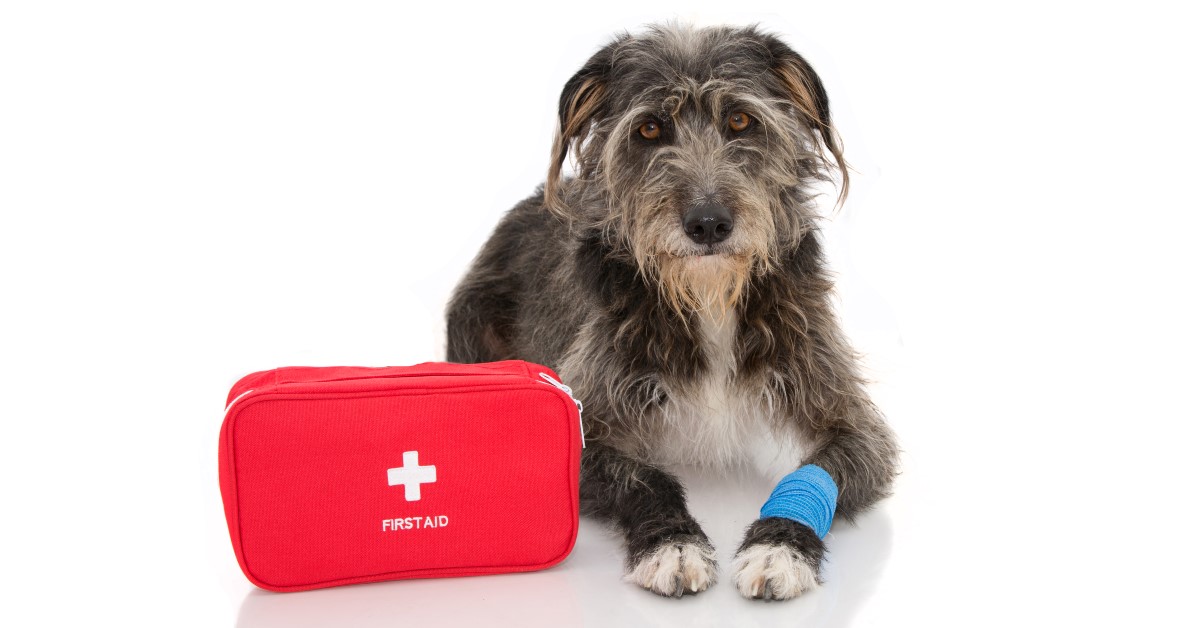What to Include in a Pet First Aid Kit
Build a pet first aid kit that will help your pet recover in the event of an injury or other emergency.

Providing your pet with the best care possible means being prepared for whatever accident or emergency may come along. From unexpected dog fights to stepping on a shard of glass, injuries can occur at any time. Having a pet first aid kit is essential to managing your pet’s injuries until you can get to a vet.
Here are some of the top supplies to put in your pet's first aid kit:
1. Vaccination & Medical Records
If you must leave the house in a hurry for an emergency veterinary visit or any other reason, having your pet’s vaccination and medical records in your pet first aid kit can come in handy.
2. Emergency Contact Card
If your pet gets injured or is in an accident, it’s important to have access to the phone number of a trusted veterinarian, a 24-hour emergency pet clinic, and the nearest animal poison control center. Write down these important phone numbers on an emergency contact card that you keep in your pet's first aid kit.
3. Hydrogen Peroxide
Hydrogen peroxide can serve multiple purposes in pet first aid. An unexpired bottle of 3 percent hydrogen peroxide can clean your pet’s wounds after an accident. If your dog gets into something poisonous, hydrogen peroxide can also induce vomiting. However, you never want to induce vomiting before first contacting your veterinarian or pet poison helpline for guidance.
4. Bandages
Bandages are a must-have for a pet first aid kit; however, you can’t effectively use standard bandages for pets due to their fur. Instead, use non-stick bandages. Self-adhering water-repellent bandages work well for dogs and cats as they can be wrapped around a limb or torso and do not require tape or other sticky substances that can get caught in your pet’s coat.
5. Antibiotic Ointment
Antibiotic ointment can be useful for preventing infection when applied to cuts, puncture wounds, abrasions, and other injuries. An ointment should only be applied to a wound once the wound has been properly rinsed and blotted dry, or allowed to air dry. Wrapping the area with non-stick gauze can help prevent your pet from licking off the ointment once applied.
6. Blunt-Tipped Scissors
Place a pair of blunt-tipped scissors in your pet's first aid kit, such as bandage scissors or heavy-duty trauma shears. These scissors can be used to safely cut or remove bandages from your pet. Blunt-tipped scissors generally have an extended “leading blade” that makes it easy to glide the scissors under the bandage. The blunt tip reduces the chance of cutting your pet’s skin.
7. Sterile Eye Solution
A sterile eye solution can be used to flush out the eyes if irritation occurs due to debris or an eye injury. Tap water should never be used to rinse out an eye as it can contain bacteria that increase your pet’s odds of developing an infection. Only use a sterile saline solution.
8. Prescription Medications
Many pet owners bring along a first aid kit during extended trips. While having basic first aid supplies is important, you don’t want to forget your pet’s prescription medications. When traveling with your pet, include a supply of medications in your pet's first aid kit so you’re prepared in case you’re not able to return home right away.
9. Rubber or Latex Gloves
Keep a couple of pairs of rubber or latex gloves in your pet's first aid kit to protect both you and your pet. You may not always be in a place where you can thoroughly wash your hands with soap and water. Wearing gloves while attending to your pet’s wounds can prevent your pet from transferring blood and other debris to you. Gloves will also reduce the risk of infection for your pet.
10. Antiseptic Wipes
Antiseptic wipes can be used on parts of your pet that are more difficult to clean, such as the face and paws. They are designed to help prevent bacterial infections without causing damage to the skin, and are best used for minor cuts, burns, and scrapes.
11. Digital Thermometer
A digital thermometer is a must-have for any pet first aid kit. Your dog or cat’s internal temperature is a reliable indicator of a more serious condition. A rectal thermometer typically provides pet owners with the most reliable results. Just make sure you keep some lubricant in the first aid kit as well to help make your pet more comfortable during the process.
12. Medical Tape & Gauze
In an emergency situation, non-stick gauze can be useful for controlling bleeding, preventing debris from entering the wound, or even making a makeshift brace if you suspect that your dog may have a fracture. Include medical tape in the kit that you can use to securely hold the gauze in place.
Preparing for Pet Emergencies
You never know what could happen that could cause illness or injury to your pet - whether at home, on the road, or visiting the neighborhood park. Having a pet first aid kit helps you stay fully prepared no matter what type of emergency situation occurs. However, it is important to remember that a pet first aid kit is not a substitute for proper vet care. If your pet suffers a serious injury, always consult with your veterinarian.
Ready to start saving money on pet wellness care?
Then take a look at Mint Wellness, the pet wellness plan that provides fast reimbursement on routine pet care. Save on vaccinations, wellness exams, preventatives, dental, and more!
Learn More